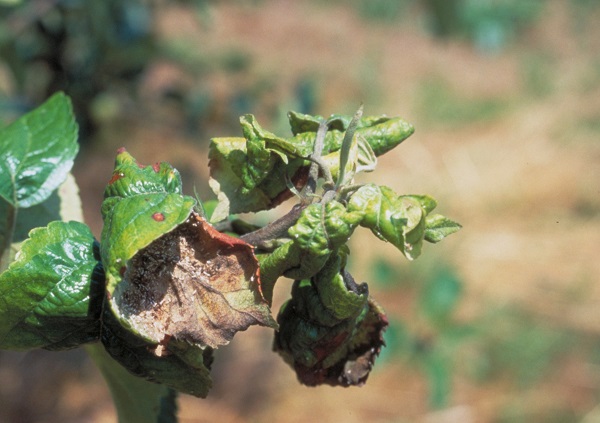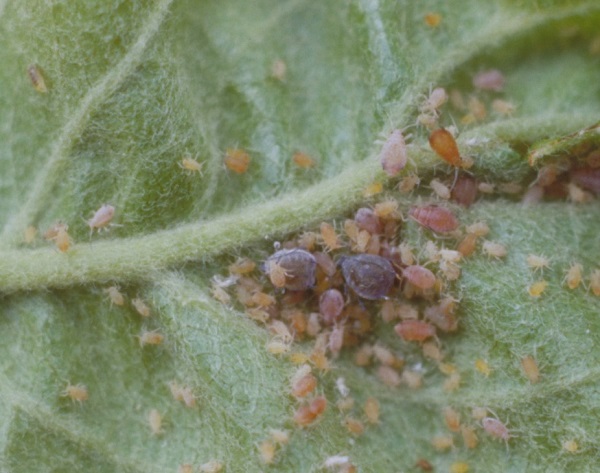Rosy Apple Aphid
ENTFACT-211: Rosy Apple Aphid | Download PDF
by Ric Bessin, Extension Specialist
University of Kentucky College of Agriculture
Generally three species of aphids - the green apple aphid, rosy apple aphid, and apple-grain aphid – attack apple foliage in Kentucky. However, it is the rosy apple aphid which causes the most severe damage and is the most difficult of the three to control. While large numbers of any type of aphid can stunt new growth and cause sooty mold to develop on fruit and leaves, the rosy apple aphid injects a toxin with its saliva that causes the leaf to curl and the fruit to be distorted. Often these damaged leaves turn bright crimson in color. Relatively low numbers of rosy apple aphids can cause considerable damage.

Figure 1. Tightly curled leaves are a sign of rosy apple aphid.
While all apple varieties are attacked by rosy apple aphid, 'Cortland', 'Ida Red', and 'Golden Delicious' are particularly susceptible. Feeding on the leaves of fruit clusters often results in stunting and malformation of the fruit. For this reason, rosy apple aphids are the most serious aphids attacking apples. Honeydew produced by the aphids promotes the growth of sooty mold as well. This becomes more noticeable as the fruit develops. Problems usually begin to appear after petal fall and by mid-summer the aphids move to alternate hosts.
The aphid overwinters on apple trees as eggs laid on twigs, bud axils, or in bark crevices. The black eggs are 1/2 mm long and football shaped. Shortly after silver tip the eggs hatch. The nymphs' color changes from dark green to purple as they grow. The overwintering eggs give rise to only female aphids which give birth to live young. The aphids continue to reproduce on apple until summer, then winged forms are produced which migrate to other hosts such as dock and narrow-leaved plantain to spend the summer. In the late fall, winged forms migrate back to apples and lay eggs in bark crevices and on twigs.

Figure 2. Leaves should be unrolled to determine of aphids are present.
Apple growers should monitor their trees carefully for rosy apple aphids. A few colonies can rapidly infest the entire tree. Because these infestations will curl the leaves, early control is important. Once the leaves are tightly curled, adequate spray coverage and control is more difficult. There are a number of predators that often control rosy apple aphid, so distorted leaves should be opened to determine if the aphids or predators are still present before making control decisions.
Rosy apple infestations often go unnoticed until the leaf curl damage is observed. Because control becomes extremely difficult once the leaves are tightly curled, rosy apple aphids are best controlled at the pink stage of bud development, before the serious leaf curl has occurred.
MANAGEMENT OPTIONS
Delayed Dormant Oil
The green apple aphid, apple-grain aphid and rosy apple aphid overwinter as eggs on twigs and bark crevices of apple trees. A delayed dormant oil application between green-tip and half-inch green controls newly hatched aphids. Failure to use a properly timed delayed dormant oil application may require additional in season treatments. These in season treatments are usually more expensive and disrupt beneficial insects that control secondary pests.
Monitoring and Economic Thresholds
Examine four leaf terminals on each of 5 scaffold limbs on each tree for active aphid colonies. Record the total number of aphid infestations per 20 leaf terminals or fruit clusters by species. If a leaf terminal has ANY live aphids on any of the leaves, it is considered infested. Treatments are recommended when 5% of the terminals are found to have rosy apple aphid infestations. Other aphids such as the green apple aphid and the apple grain aphid do not curl leaves and have higher action thresholds of 50% infested terminals.
Effective control of rosy apple aphid can only occur prior to leaf curl. Trees need to be examined for rosy apple aphids at the pink stage of development. Malathion can provide effective control of these pests when they exceed thresholds.
Insecticidal Soap and Summer Horticultural Oil
A 1 to 2% application of insecticidal soap or summer horticultural oil can provide effective control of these aphids. Use the monitoring and economic thresholds and apply these as necessary. Neither of these will provide any residual control, so thorough coverage is essential. Control of rosy apple aphid after the leaves have curled may be difficult. While effective control can be obtained with a 1 to 2% summer horticultural oil treatment, caution is advised as these may be incompatible with some other pesticides (particularly sulfur containing products), are phytotoxic at higher temperatures (above 100˚F and high humidity) and at high concentrations (>2%), and may affect fruit finish on some varieties.
Revised: 11/19
CAUTION! Pesticide recommendations in this publication are registered for use in Kentucky, USA ONLY! The use of some products may not be legal in your state or country. Please check with your local county agent or regulatory official before using any pesticide mentioned in this publication.
Of course, ALWAYS READ AND FOLLOW LABEL DIRECTIONS FOR SAFE USE OF ANY PESTICIDE!
Photos courtesy Ric Bessin, University of Kentucky Entomology
